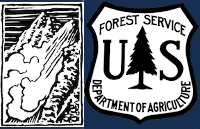Snowpack and Avalanche Discussion
<p>This morning, avalanche conditions are generally safe, and slides are unlikely. Warming during the day will unlock snow surfaces and make <strong>wet loose </strong>and <strong>wind slab avalanches</strong> possible. Thankfully, both of these problems will result in relatively small avalanches and are avoidable by timing your day thoughtfully and identifying key terrain features.</p>
<p>Increasing cloud cover and winds may keep snow surfaces cooler than yesterday and multiple days of subsequent freezing and thawing temperatures took the edge off the wet snow danger. However, as the sun and above-freezing temperatures melt snow surfaces, <strong>wet loose avalanches</strong> may occur naturally or with human triggers. Last week’s snow sits above firm crusts, a bed surface that can result in long-running slides. Move to lower-angle terrain or colder, drier slopes on northern aspects when the top few inches of snow become wet or roller balls signal deteriorating stability. Stability will be best first thing in the morning and progressively worsen on slopes in direct sun.</p>
<p>Snow surfaces are hardening, and <strong>wind slab avalanches</strong> are becoming less likely as time separates us from the most recent snowfall and wind loading events. Slabs of drifted snow often present as textured, stiff or rounded snow surfaces. The most likely location for this problem is immediately below corniced ridgelines and in upper elevation gullies holding dry snow. Either avoid these isolated locations or evaluate drifted slopes for instability. While these wind slabs are relatively small, they can push skiers and riders into rocks and off cliffs in steep terrain.</p>
<p>A related concern is <strong>cornice fall</strong>. These overhanging masses of snow near ridgelines are enormous and can break unpredictably far from the edge, especially during spring warm-ups. Minimize your time on slopes below cornices and stay far from the edge while travelling above them.</p>
<p><strong>Recent Avalanche Activity: </strong>Yesterday, skiers south of Cooke City noted a pair of relatively small wet loose avalanches (<a href="https://www.mtavalanche.com/node/34867"><strong><span>details</span></s…;). On Saturday in the Bridger Range, skiers triggered wind slab avalanches on Saddle Peak and The Great One; some loose snow avalanches occurred naturally (<a href="https://www.mtavalanche.com/node/34844"><strong><span>Saddle Peak</span></strong></a>, <a href="https://www.mtavalanche.com/node/34845"><strong><span>The Great One</span></strong></a>, <a href="https://www.mtavalanche.com/images/25/natural-loose-slides-bridge-ridge…;), and in Cooke City, wind drifts breaking up to 8 inches deep were more reactive than anticipated (<a href="https://www.mtavalanche.com/node/34848"><strong><span>observation and video</span></strong></a>).</p>
<p><span>The avalanche danger is LOW this morning and will rise to MODERATE as surface crusts break down. </span></p>
Hyalite Road Closure
The Hyalite Canyon Road is closed to ALL MOTORIZED VEHICLES until May 16. This is a regular annual road closure to reduce road damage during the spring thaw. Bicycle and foot traffic are allowed. Contact the Bozeman FS Ranger District for more info.
